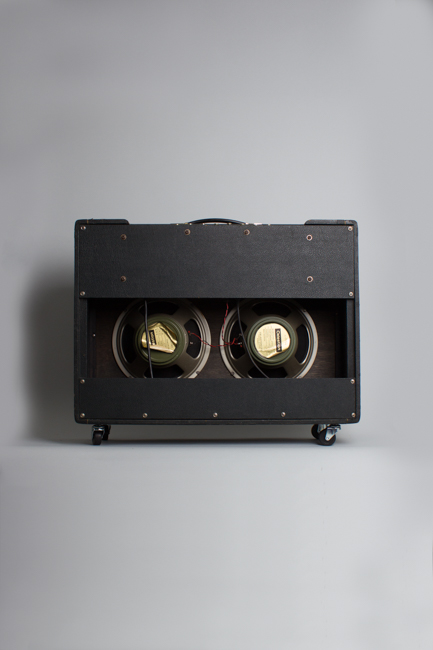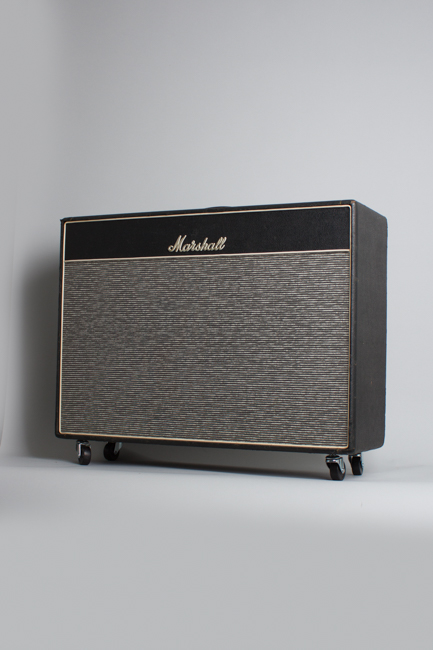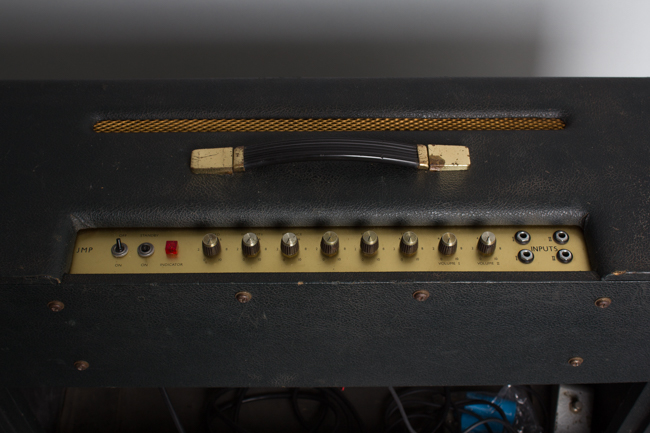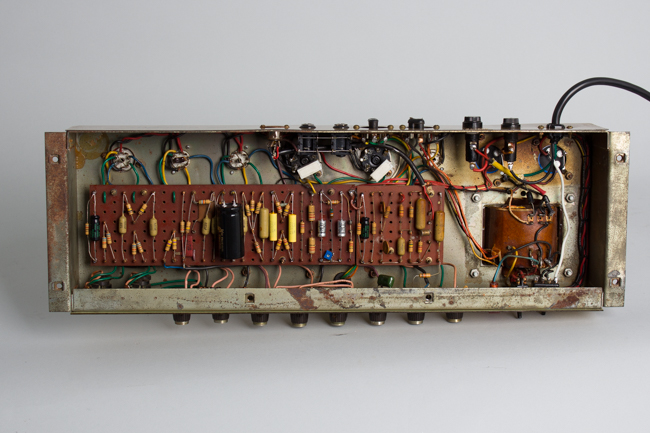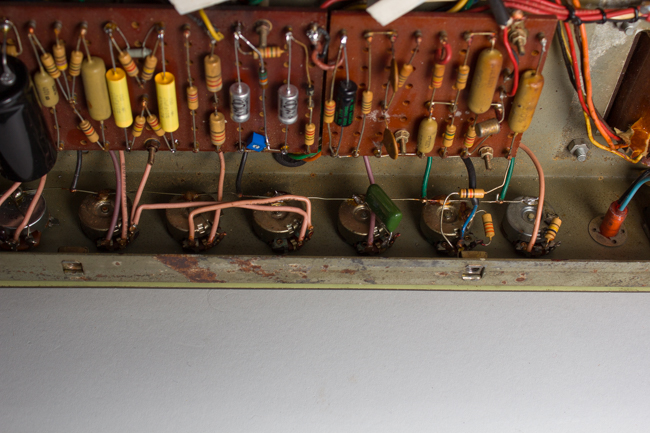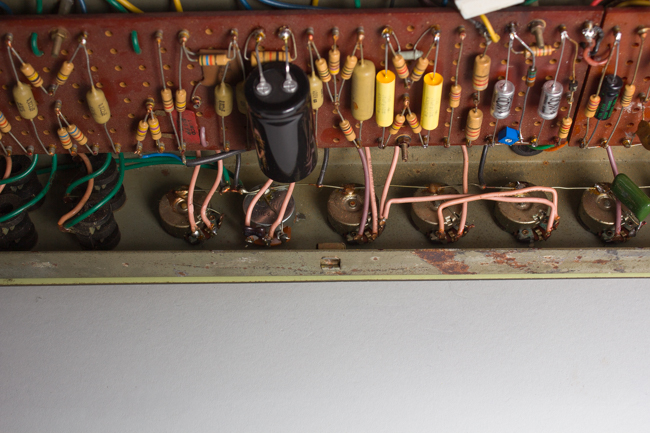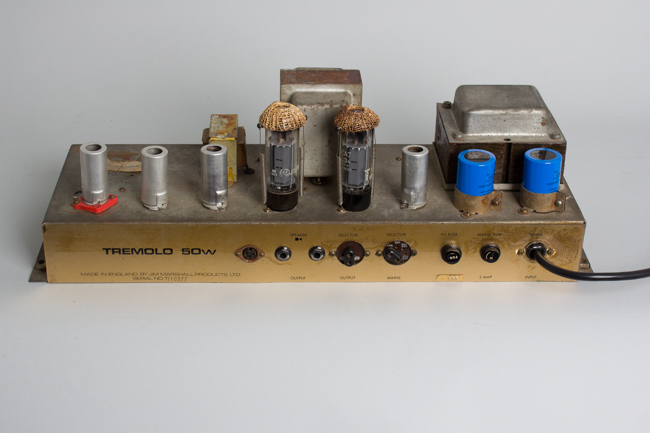Marshall Model 1961 'Bluesbreaker' Tube Amplifier (1968)
This item has been sold.
Item # 12307
Prices subject to change without notice.
Marshall Model 1961 'Bluesbreaker' Model Tube Amplifier (1968), made in London, England, serial # 10377, black tolex covering finish.
Marshall amps are certainly a rock legend, with a sound that has defined entire styles and eras of music. This Model 1961, a.k.a. "Bluesbreaker "combo from 1968 is a standouts; it has been converted to the preferred 2x12 speaker layout from an original 4x10 but is otherwise largely original. It is nicknamed after the iconic 1966 John Mayall & The Bluesbreakers LP recording session where this style Marshall was used by Eric Clapton in combination with a sunburst Les Paul standard. That guitar and amplifier combination is credited with changing the sound of blues/rock guitar forever and inspiring the British heavy blues-rock boom of the later 1960s.
All Marshall amps owe their humble beginnings to the Fender Bassman 5F6-A, the original subject re-interpreted using English components and originally sold exclusively through Jim Marshall's London shop. Both the circuit design and sound soon evolved from the Fender paradigm into something entirely their own. Beyond the iconic Mayall sessions early Marshalls powered the sound of the Who, Cream, Hendrix and beyond, becoming de rigeur among top UK groups by 1968.
The Models 1961 and 1962 were Marshall's first combo amplifiers, initially marketed in 1962 at around half the cost of a new Fender Bassman. The model numbers referred to the two different speaker compliments, 4x10" and 2x12", respectively. The circuit was essentially the same as the JTM45, with added on-board tremolo in a combo format. The Summer of 1965 brought revamped cosmetics across the line and the "Series 2" iteration of the combo models saw the new split-front appearance with a straight baffle and the new script Marshall logo. After the introduction of the 100-watt Super models in 1966, the combo models experienced a handful of further design changes including a switch to EL34 power tubes and solid-state rectification. The "JMP" designation was added to the Plexi control panels, now featuring the familiar Marshall knobs. Lastly, Celestion G12M speakers were used for the 2x12" models.
Like the initial JTM-45 models, the 1961/1962 models feature four inputs and two channels, often jumpered with a short lead for more preamp gain. The two channels share treble, middle, bass and presence controls and have a separate volume control for each. The added tremolo effect also has dedicated speed and intensity controls. The two EL34 power tubes yield around 50 watts of power into either two 12" or four 10" Celestion speakers.
This Model 1961 is the most important combo amplifier in the company's history, and many would say it is the "definitive rock amplifier" at least if one is not rocking a full stack. After the release of the "John Mayall Bluesbreakers with Eric Clapton" (The "Beano" LP) in June 1966 the raging but still incisive overdriven sound Clapton pioneered became the new gold standard for ambitious blues and rock guitarists, although at the time the part played by the Marshall model 1961 was often underappreciated. In the decades since the amplifier has gained truly legendary status as one of the great tone machines of all time.
Height is 26 1/2 in. (67.3 cm.), 32 in. (81.3 cm.) width, and 10 1/2 in. (26.7 cm.) deep.
Cosmetically, this monstrous combo is in very nice shape for 55+ years on the planet. It has had one major alteration, a conversion from the original 4x10" to a 2x12" format including a new baffle and grille cloth. The cabinet otherwise appears original, including the cutouts near the baffle edges allowing for the very snugly-fit original arrangement of four 10" speakers. The original black Tolex covering shows some typical scuffing and edge-wear but is overall in great shape considering its age. The Plexi control panel is in wonderful condition with no visible cracks or deformation and although some of the knobs have a differently-worn patina, they all appear to be at least period. The handle and hardware is original and the amp also retains its original footswitch for the onboard tremolo effect. The amp has new replacement casters.
Electrically, the amp is nicely original, save for the two 12" Celestion G12M speakers. Both speakers appear older/period but lack any visible date codes. The Drake power, choke and output transformers are original and bear the codes 1202-118 and 784-139, respectively. The Speed and Volume I pots are both replacements, the remainder appearing original. The amp has otherwise seen our typical maintenance and servicing, including replacement of all electrolytic capacitors, a grounded 3-prong power cord, cleaning of all sockets, pots and jacks and power tubes biased to spec.
This is fabulous example of one of the most iconic amplifiers of rock history. While it has been modified from its original speaker layout for most players it now offers the more desirable format, set up like the one used in those legendary 'Beano' LP sessions. You don't actually need a "Burst" to drive this amp into truly heavenly overdrive, but it wouldn't hurt either! Overall Very Good + Condition.
Marshall amps are certainly a rock legend, with a sound that has defined entire styles and eras of music. This Model 1961, a.k.a. "Bluesbreaker "combo from 1968 is a standouts; it has been converted to the preferred 2x12 speaker layout from an original 4x10 but is otherwise largely original. It is nicknamed after the iconic 1966 John Mayall & The Bluesbreakers LP recording session where this style Marshall was used by Eric Clapton in combination with a sunburst Les Paul standard. That guitar and amplifier combination is credited with changing the sound of blues/rock guitar forever and inspiring the British heavy blues-rock boom of the later 1960s.
All Marshall amps owe their humble beginnings to the Fender Bassman 5F6-A, the original subject re-interpreted using English components and originally sold exclusively through Jim Marshall's London shop. Both the circuit design and sound soon evolved from the Fender paradigm into something entirely their own. Beyond the iconic Mayall sessions early Marshalls powered the sound of the Who, Cream, Hendrix and beyond, becoming de rigeur among top UK groups by 1968.
The Models 1961 and 1962 were Marshall's first combo amplifiers, initially marketed in 1962 at around half the cost of a new Fender Bassman. The model numbers referred to the two different speaker compliments, 4x10" and 2x12", respectively. The circuit was essentially the same as the JTM45, with added on-board tremolo in a combo format. The Summer of 1965 brought revamped cosmetics across the line and the "Series 2" iteration of the combo models saw the new split-front appearance with a straight baffle and the new script Marshall logo. After the introduction of the 100-watt Super models in 1966, the combo models experienced a handful of further design changes including a switch to EL34 power tubes and solid-state rectification. The "JMP" designation was added to the Plexi control panels, now featuring the familiar Marshall knobs. Lastly, Celestion G12M speakers were used for the 2x12" models.
Like the initial JTM-45 models, the 1961/1962 models feature four inputs and two channels, often jumpered with a short lead for more preamp gain. The two channels share treble, middle, bass and presence controls and have a separate volume control for each. The added tremolo effect also has dedicated speed and intensity controls. The two EL34 power tubes yield around 50 watts of power into either two 12" or four 10" Celestion speakers.
This Model 1961 is the most important combo amplifier in the company's history, and many would say it is the "definitive rock amplifier" at least if one is not rocking a full stack. After the release of the "John Mayall Bluesbreakers with Eric Clapton" (The "Beano" LP) in June 1966 the raging but still incisive overdriven sound Clapton pioneered became the new gold standard for ambitious blues and rock guitarists, although at the time the part played by the Marshall model 1961 was often underappreciated. In the decades since the amplifier has gained truly legendary status as one of the great tone machines of all time.
Height is 26 1/2 in. (67.3 cm.), 32 in. (81.3 cm.) width, and 10 1/2 in. (26.7 cm.) deep.
Cosmetically, this monstrous combo is in very nice shape for 55+ years on the planet. It has had one major alteration, a conversion from the original 4x10" to a 2x12" format including a new baffle and grille cloth. The cabinet otherwise appears original, including the cutouts near the baffle edges allowing for the very snugly-fit original arrangement of four 10" speakers. The original black Tolex covering shows some typical scuffing and edge-wear but is overall in great shape considering its age. The Plexi control panel is in wonderful condition with no visible cracks or deformation and although some of the knobs have a differently-worn patina, they all appear to be at least period. The handle and hardware is original and the amp also retains its original footswitch for the onboard tremolo effect. The amp has new replacement casters.
Electrically, the amp is nicely original, save for the two 12" Celestion G12M speakers. Both speakers appear older/period but lack any visible date codes. The Drake power, choke and output transformers are original and bear the codes 1202-118 and 784-139, respectively. The Speed and Volume I pots are both replacements, the remainder appearing original. The amp has otherwise seen our typical maintenance and servicing, including replacement of all electrolytic capacitors, a grounded 3-prong power cord, cleaning of all sockets, pots and jacks and power tubes biased to spec.
This is fabulous example of one of the most iconic amplifiers of rock history. While it has been modified from its original speaker layout for most players it now offers the more desirable format, set up like the one used in those legendary 'Beano' LP sessions. You don't actually need a "Burst" to drive this amp into truly heavenly overdrive, but it wouldn't hurt either! Overall Very Good + Condition.


